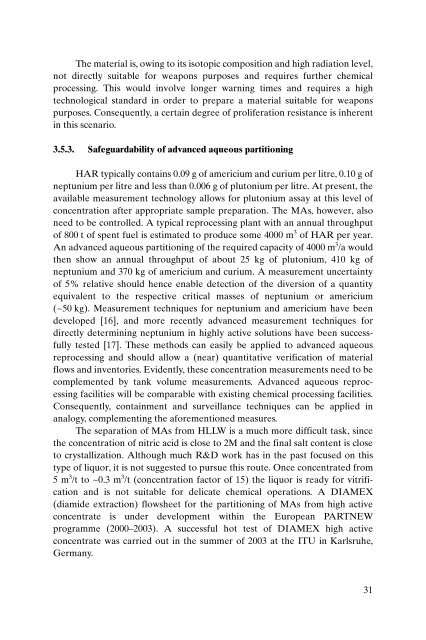TRS435_web
TRS435_web
TRS435_web
Create successful ePaper yourself
Turn your PDF publications into a flip-book with our unique Google optimized e-Paper software.
The material is, owing to its isotopic composition and high radiation level,<br />
not directly suitable for weapons purposes and requires further chemical<br />
processing. This would involve longer warning times and requires a high<br />
technological standard in order to prepare a material suitable for weapons<br />
purposes. Consequently, a certain degree of proliferation resistance is inherent<br />
in this scenario.<br />
3.5.3. Safeguardability of advanced aqueous partitioning<br />
HAR typically contains 0.09 g of americium and curium per litre, 0.10 g of<br />
neptunium per litre and less than 0.006 g of plutonium per litre. At present, the<br />
available measurement technology allows for plutonium assay at this level of<br />
concentration after appropriate sample preparation. The MAs, however, also<br />
need to be controlled. A typical reprocessing plant with an annual throughput<br />
of 800 t of spent fuel is estimated to produce some 4000 m 3 of HAR per year.<br />
An advanced aqueous partitioning of the required capacity of 4000 m 3 /a would<br />
then show an annual throughput of about 25 kg of plutonium, 410 kg of<br />
neptunium and 370 kg of americium and curium. A measurement uncertainty<br />
of 5% relative should hence enable detection of the diversion of a quantity<br />
equivalent to the respective critical masses of neptunium or americium<br />
(~50 kg). Measurement techniques for neptunium and americium have been<br />
developed [16], and more recently advanced measurement techniques for<br />
directly determining neptunium in highly active solutions have been successfully<br />
tested [17]. These methods can easily be applied to advanced aqueous<br />
reprocessing and should allow a (near) quantitative verification of material<br />
flows and inventories. Evidently, these concentration measurements need to be<br />
complemented by tank volume measurements. Advanced aqueous reprocessing<br />
facilities will be comparable with existing chemical processing facilities.<br />
Consequently, containment and surveillance techniques can be applied in<br />
analogy, complementing the aforementioned measures.<br />
The separation of MAs from HLLW is a much more difficult task, since<br />
the concentration of nitric acid is close to 2M and the final salt content is close<br />
to crystallization. Although much R&D work has in the past focused on this<br />
type of liquor, it is not suggested to pursue this route. Once concentrated from<br />
5 m 3 /t to ~0.3 m 3 /t (concentration factor of 15) the liquor is ready for vitrification<br />
and is not suitable for delicate chemical operations. A DIAMEX<br />
(diamide extraction) flowsheet for the partitioning of MAs from high active<br />
concentrate is under development within the European PARTNEW<br />
programme (2000–2003). A successful hot test of DIAMEX high active<br />
concentrate was carried out in the summer of 2003 at the ITU in Karlsruhe,<br />
Germany.<br />
31


